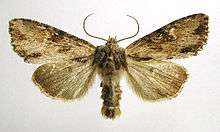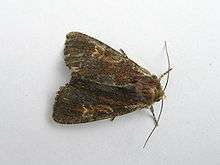Apamea crenata
Apamea crenata, known as the clouded-bordered brindle, is a moth in the Noctuidae family. It is distributed throughout the Palearctic ecozone.

| Clouded-bordered brindle | |
|---|---|
 | |
| Scientific classification | |
| Kingdom: | |
| Phylum: | |
| Class: | |
| Order: | |
| Family: | |
| Tribe: | |
| Genus: | Apamea |
| Species: | A. crenata |
| Binomial name | |
| Apamea crenata (Hufnagel, 1766) | |
Distribution
The Apamea crenata occupies varied habitats. It colonizes grass-rich, uncut, and moist to mesophilic places such as wet meadows, fens, forest edges or clearcuts. This moth is abundant in Europe and Asia, most prevalently in cooler climes. This species particularly avoids hot regions and sometimes appears in mountains.
Description and variation
This species has a wingspan of 36 to 44 mm. The forewings are pale brown with darker patches along the margins, usually with prominent markings at the base and tornus. The hindwings are grayish with darker venation. Melanic forms occur fairly frequently. This moth flies at night and is attracted to light and sugar, particularly nectar-rich flowers. In the British Isles, it is active from May to July.
Morphology
A. crenata has a pale, lilac-grey forewing, often washed in pale brown. The veins are pale, with a coastal area tinged with purplish grey, and the inner margin tinted with white. It has a thick black streak near the base, with double inner and outer lines. A brownish outer line is followed by a double row of dark-brown vein dots with a white dot between. The claviform stigma is brown, with a darker outline. The orbicular is generally elongated and narrow, sometimes shortened and rounder, with a brown, reniform-shaped centre and a pale outline.
The outer half of the reniform is paler than the inner, and the lower lobe is a darker cell and median shade brown, the latter not reaching below the cell; the marginal area beyond submarginal line is dark red-brown, emitting large teeth inwards on the two folds. The hind-wing is fuscous, pale grey towards the base; [abbreviation argentea Tutt is a form from Scotland in which the ground colour] of fore-wings is shiny whitish, with traces of faint brownish costal streaks. The terminal area and basal streaks are pale brown. It lacks all other markings, except a trace of reniform stigma. The hind-wing is pale grey; - ochrea Tutt and intermedia Tutt seem to represent merely the type form when washed with pale ochreous, or with rufous ochreous respectively, this latter is the commonest form in Britain.
Flavorufa Tutt is a rare species. It is found only in the north of England and Scotland. It is a dull yellow red. It lacks the usual markings, except the stigmata, which are distinct and outlined with yellow markings. Short, yellow dashes may appear on its body, with a yellow patch at the base of the costa, and/or some yellow scales on the dark veins.
The putris moth's fore-wing is suffused with dull grey-brown, with the middle area between inner and outer lines darker brown from the costa to the inner margin. The white scales of inner margin are plainer. Some examples are more uniformly dark and with obscured markings, while others are paler brown and show the markings clearly.
The combusta moth is a dark fuscous form of this breed, in which the basal area and both hues are mixed with white scales, the outer edge of the reniform is also whitish.
The alopecurus is red-brown with dark veins, the costa, and inner margin and sometimes the veins dusted white, with yellow-edgd stigmata; the two folds are redder than the rest. In some cases, this red tint predominates and makes the whole wing red. In others the blackish shades overpower the red, these are classified as nigrorubida.
The subarea Petersen is a form with the fore-wing darkened with grey-brown, with clear markings, and the reniform not picked out with yellow.
The extincta from Issykkul and Kuku Nor has the fore-wing pale uniform lilac grey. The terminal area and the cell are a dull red-brown. The hues are very indistinctly expressed and the stigmata a pale grey. The outer edge of the reniform will be whitish with a dark form corresponding to this.
The uniformis is a completely dull dark liver colour, with no markings except the pale inner and outer lines and the whitish outer edge of the reniform stigma. The hind-wing, like the extincta, is a smooth pale grey.[1]
Ecology
The larva feeds on various grasses including orchard grasses, tussock grasses, fescues, and canarygrasses. This species overwinters as a larva and feeds in mild weather throughout the season.[2]
References
- Seitz, A. Ed., 1914 Die Großschmetterlinge der Erde, Verlag Alfred Kernen, Stuttgart Band 3: Abt. 1, Die Großschmetterlinge des palaearktischen Faunengebietes, Die palaearktischen eulenartigen Nachtfalter, 1914
- "Robinson, G. S., et al. 2010. HOSTS – A Database of the World's Lepidopteran Hostplants. Natural History Museum, London".
Further reading
- Chinery, M. Collins Guide to the Insects of Britain and Western Europe. 1986 (Reprinted 1991)
- Skinner, B. Colour Identification Guide to Moths of the British Isles. 1984
External links
| Wikimedia Commons has media related to Apamea crenata. |